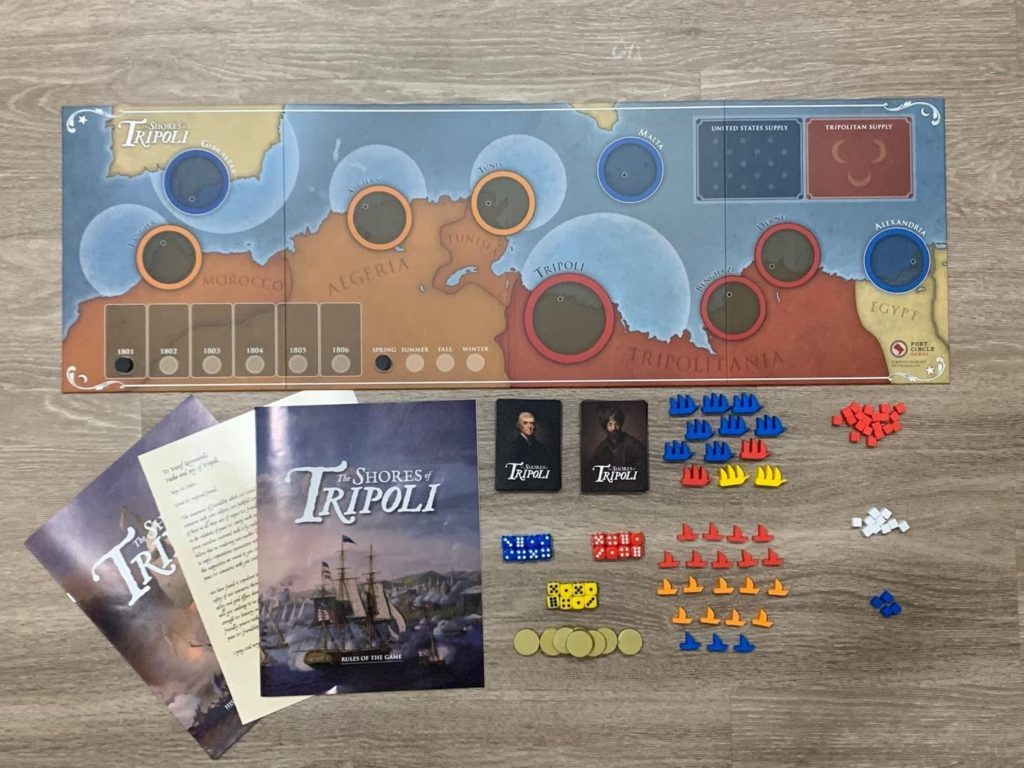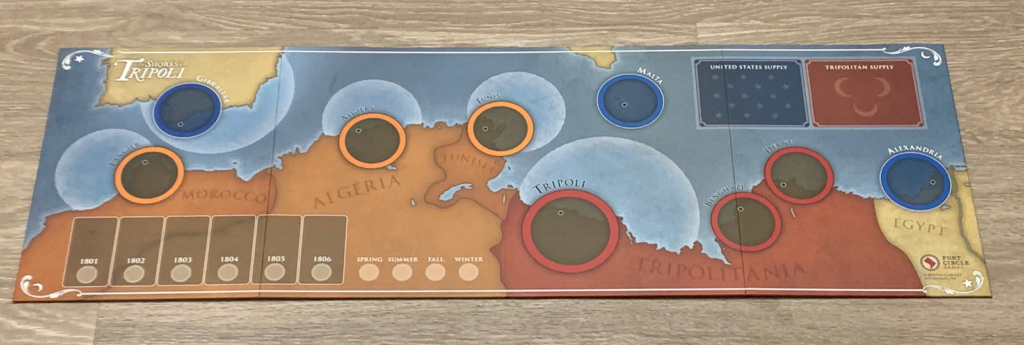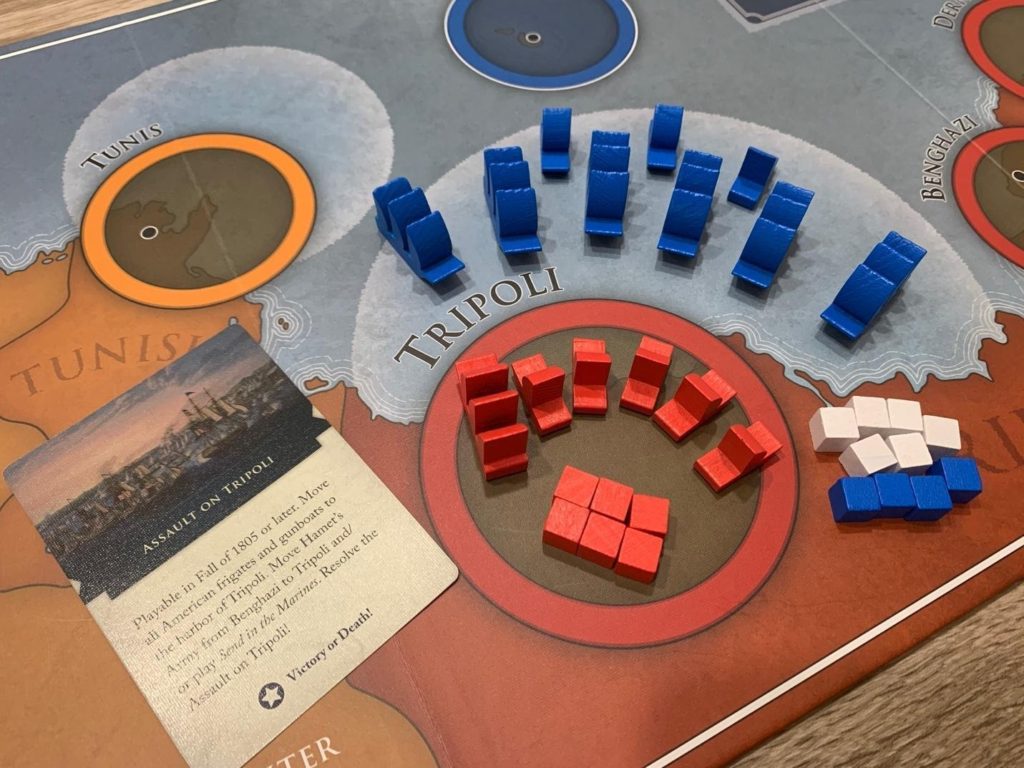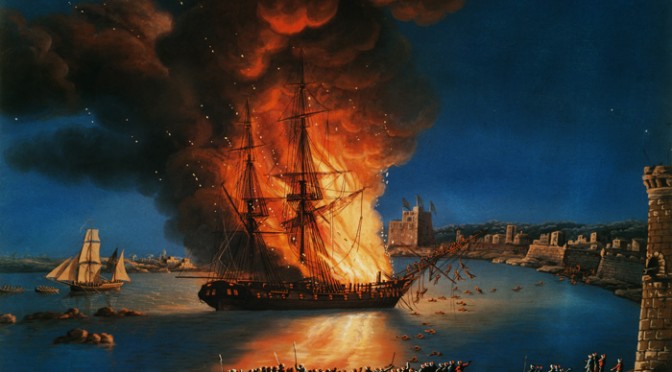By Caitlyn Leong and Ens. Brandon Bridges, USN
The Shores of Tripoli (SoT) is a one-to-two-player card-driven wargame by designer Kevin Bertram and Fort Circle games. SoT presents players with the opportunity to make strategic choices on behalf of the U.S. Navy and Marine Corps or the pirates of Tripoli during the First Barbary War. Our review focuses on the two-player game experience and we outline the game components, basic rules, and our thoughts on the value of the game as both a wargame and a means of learning history. While not heavily focused on the tactics or international politics of the First Barbary War, SoT accurately captures the high-level strategic decisions and asymmetries of the actual conflict, allowing players to develop insights that are relevant to history and to contemporary conflict dynamics. Overall, SoT is an excellent game for those who are interested in the First Barbary War, and both new and experienced wargamers.
Game Components
The Shores of Tripoli arrives as a boxed set, with high-quality wood components, card decks for the American and Tripolitan player, a full-color game map, and a bag of twenty-four six-sided dice. The box also contains a historical supplement with designer’s notes and a copy of Thomas Jefferson’s 1801 letter to Yusuf Qaramanli, the pasha of Tripoli.

The large three-masted ships represent frigates. The blue frigates represent the U.S. Navy, the red frigates are Tripolitan, and the two yellow frigates represent the Swedish Navy, which had been engaged in conflict with Tripoli since the late 1790s. The smaller single-masted vessels represent American gunboats (blue) and pirate corsairs (red and orange). The orange corsairs represent the pirate forces of the Tripolitan allies in Algiers, Tangier, and Tunis. Ground units are represented by wooden cubes, blue for U.S. Marine Corps, white for Arab infantry that fought alongside the U.S., and red for Tripolitan infantry. The twelve gold coins represent tribute and stolen treasure that the Tripolitan player can attempt to win throughout the game.
The map has three different types of playable areas. The color-coded circles represent the nine harbors in the region. The colors indicate whether the harbor is friendly for the Americans or the Tripolitans, although they can peacefully coexist in Gibraltar. The lightly-shaded semicircles outside of five of the harbors represent patrol zones, which American frigates can patrol to try and prevent pirate corsairs from leaving the harbor. Everything outside of the harbors and patrol zones is the open sea, where the corsairs may engage in piracy against merchant ships that are not physically represented in the game.

At the bottom of the map, a turn tracker marks the year and the season. The game begins in the spring of 1801. The upper right corner of the map also features a designated supply area where extra American and Tripolitan pieces, along with their allies’ pieces may be stored for ease of access during gameplay.
Victory Conditions and Combat Adjudication
SoT offers multiple paths to victory for both the American and Tripolitan players. The asymmetries between these objectives make for very engaging gameplay. The American player wins by either forcing the Tripolitan player to sign the Treaty of Peace and Amity (1805 or later) if certain conditions are met, or by capturing Tripoli, which requires defeating both the Tripolitan pirate fleet and infantry. The Tripolitan player has three paths to victory. First, they can sink a total of four American frigates, forcing the Americans to acquiesce on the basis of having lost too much of their nascent fleet. Alternatively, Tripolitan corsairs and their allies in Tunis, Algiers, and Tangier can win by acquiring twelve gold coins, reflecting their ability to prey on Mediterranean trade successfully. Finally, if the Tripolitans can defeat and eliminate Hamet’s Army (the American ground force), they win. If neither player has achieved victory before 1806, the game ends in a draw.
SoT features two types of combat: naval and ground. In both types of combat, the results are adjudicated by simple dice rolls, which, regardless of the apparent strength of the attacking force, can leave a lot to chance. The American player also has the option to conduct a naval bombardment of enemy infantry. Regardless of the type of combat, players roll dice based on their units’ strength and can modify these rolls for better results using cards.
The Two-Player Game Experience
In order to thoroughly test the game’s iterability and the likelihood of in-game events, we played the two-player version of SoT twelve times before writing this review. We noted on our first playthrough that SoT has a very low barrier to entry in terms of learning the rules and understanding the game’s dynamics. This is especially important if one is new to wargaming or wants to play with someone who is.
Game set-up is fairly simple and outlined clearly in the rulebook. Each player gets event cards that allow them to take certain actions during the game and draws a hand of eight cards from their deck. At the start of each subsequent year, players will draw cards from the deck and discard excess cards from their hand, if necessary. One card must be played per season by each player.
For the first game, we recommend being very slow in assessing your hand and your options and making sure to move the season tracker. When we tried to move too quickly in our first few games, we each lost track of the season and missed some critical moves made by our opponent. That said, we never had a game last longer than an hour, so SoT is a great game to play if you want minimal setup and quick play.
Our games made it clear that players must balance competing strategic objectives based on the cards they draw and the current year and season. Some cards can only be played after a certain year or season has passed, particularly the American victory condition cards. Some cards can also be stacked with each other to make their effects stronger or modify combat but using certain cards may permanently remove them from the game. Consequently, successful players must choose their path to victory and identify the cards that they will need to achieve that victory relatively early in the game.
We found that as we gained more experience with the game, we became better at planning our hands and playing the right cards together to achieve certain effects or strategic objectives. This also made the game more challenging, since each of us was more familiar with the other player’s deck and strategic choices. However, we did not have a game that ended in a draw. In our testing of the game, we found that the Tripolitan player is most likely to win by amassing the requisite twelve gold coins, while the American is most likely to win by assaulting Tripoli.
While much of the game’s progression towards victory depends on a player’s hand, much also depends on the roll of the dice. As previously mentioned, strategies that may work in other games, such as massing forces or stacking modifying cards in one final climactic battle may not be enough to win SoT. In one game the entirety of the American Navy and Hamet’s Army (supported by extra Arab infantry) assaulted Tripoli, but lost four frigates to the Tripolitans, resulting in a last-minute Tripolitan victory.

We also had several games where the Tripolitans reached twelve gold coins just before the American player could play the Treaty of Peace and Amity in 1805. While this can be incredibly frustrating if it happens routinely, (we did play the game twelve times in fairly short order), we felt that this contributed to the opportunity to explore counterfactuals through SoT.
The History of the First Barbary War and the Historic Counterfactuals in Shores of Tripoli
Learning about conflict dynamics and history through wargames can reveal new insights and inform understandings of contemporary conflict dynamics. To that end, SoT offers players an opportunity to understand the challenges of strategic decision-making, particularly during a protracted and asymmetric conflict like the First Barbary War. The First Barbary War lasted from 1801 to 1805. The war began in 1801 when Tripoli formally declared war after years of tensions over the tributes required to ensure merchant ships’ safe passage in the Mediterranean. At the time of the war, the US had just started building the first six frigates of the U.S. Navy and had barely been acknowledged as a nation by the European powers.
By contrast, Tripoli and its allies, Tunis, Algiers, and Tangier, were semi-autonomous states belonging to the Ottoman Empire, whose pirate corsairs extorted merchant ships and effectively controlled trade throughout the Mediterranean. England and France had much greater ability to pay the requisite tribute to Tripoli to ensure their trade routes would remain safe, and the steady stream of payment allowed Tripoli to drive up the tribute prices to exorbitant sums that the Americans could ill afford. As a result, American merchant ships were frequently captured, and their crews were held for ransom or sold into slavery. The U.S. Navy was simply not large enough at the time to provide escorts for their merchant vessels, of which the Tripolitans took full advantage.
As in history, some of the Tripolitan victory conditions in SoT involve making the cost of the war too high for the US in terms of their military assets or the ongoing costs associated with the loss of their merchant ships and ransoming their crews. Similarly, the American player can win by establishing the actual conditions that lead to the Treaty of Peace and Amity in 1805 or by eliminating the Tripolitan fleet and ground forces in that same year or later.
The cards in SoT highlight key events and elements of the conflict that affected the progression of the First Barbary War. In the game, these events may not occur exactly when they occurred in history, which adds a strong element of the historical counterfactual to gameplay in ways that may be fun for wargamers and casual players, but less so for hardline historians and naval tacticians.
What makes SoT interesting and fun to play over and over is the opportunity to test the counterfactual. For example, what if Tripoli and its allies were much more successful at sinking American frigates than they were during the war? Or what if Thomas Jefferson actually provided the necessary naval reinforcements for the intended 1805 assault on Tripoli? These counterfactual events lead to very different victory conditions than what occurred in history (the signing of the Treaty of Peace and Amity in 1805), and present an opportunity for players to consider what elements of the conflict mattered at the strategic level and during what year or season they are most significant.
Through our numerous playthroughs, we found that certain types of victory are more likely to occur for both the American and Tripolitan player, in ways that occasionally deviate from history. We found that a successful American assault on Tripoli was the most common ending in our twelve games. We debated whether this is a good thing and have concluded that if you are looking to learn more about the strategic dynamics of the First Barbary War and understand that SoT abstracts the majority of tactics, international relations, and logistical challenges that occurred during the war, you will likely get a lot of value out of SoT.
Gamers looking for precisely-modeled combat and naval tactics may find that SoT is not the right game for them. However, SoT is a strong entry-level wargame that highlights the key historical events and figures of the war without being bogged down by the minutiae of history.
Caitlyn Leong is a M.A. candidate and CyberCorps Scholarship for Service Fellow at Georgetown’s Security Studies Program. She currently serves as the President of the Georgetown University Wargaming Society and previously served as Director of Simulations for The George Washington University’s Strategic Crisis Simulations. She specializes in wargaming, emerging technologies, and cybersecurity policy.
ENS Brandon Bridges is a prospective Surface Warfare Officer in the United States Navy. His views are his own and do not represent the views of the U.S. Navy or Department of Defense.
Featured Image: A painting of the burning of the captured USS Philadelphia by Stephen Decatur. Decatur led a small team aboard Philadelphia, which had been captured by the Tripolitans, and burned the ship rather than let it be used as a corsair vessel. (Painting by Niccolo Calyo from the collection of the Mariners’ Museum of Newport News, Va.)

